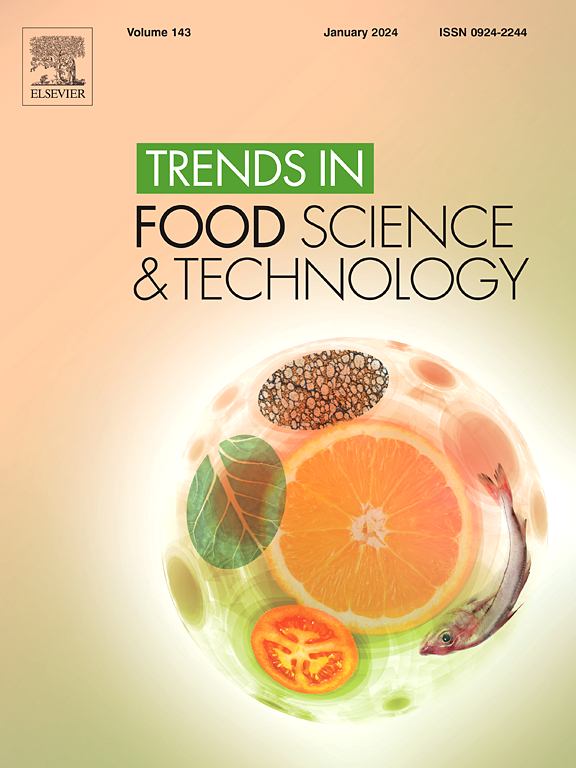精密工程木质素基食品包装材料
IF 15.1
1区 农林科学
Q1 FOOD SCIENCE & TECHNOLOGY
引用次数: 0
摘要
木质素是自然界中最丰富的芳香族生物聚合物,已成为开发下一代可持续食品包装材料的有力候选者。其固有的多功能性,包括抗氧化,抗菌和吸收紫外线的特性,赋予木质素相当大的潜力集成到先进的包装系统。然而,木质素从生物质转化为功能包装材料仍然受到一些关键挑战的阻碍,例如其固有的脆性、水分敏感性以及加工成柔性、耐用薄膜的困难。本文综述了控制木质素基包装材料性能的结构-性能关系的综合分析。木质素结构和材料性能之间的关系是严格检查和探索策略,以利用木质素的功能在各种包装格式,包括薄膜,涂料,水凝胶和纸基复合材料。特别注意的是,在合理设计的木质素为基础的系统主动和智能包装应用的最新进展。虽然已经取得了重大进展,但需要进一步的研究来克服现有的限制,并实现可扩展的商业部署。该综述总结了木质素在塑造可持续包装未来中的作用的前瞻性观点,旨在激发生物质衍生材料的持续创新,并为其开发和实施提供战略框架。本文章由计算机程序翻译,如有差异,请以英文原文为准。

Precision-engineered lignin-based food packaging materials
Lignin, the most abundant aromatic biopolymer in nature, has emerged as a compelling candidate for the development of next-generation sustainable food packaging materials. Its intrinsic multifunctionality, including antioxidant, antimicrobial, and UV-absorbing properties, endows lignin with considerable potential for integration into advanced packaging systems. However, the translation of lignin from biomass to functional packaging materials remains hindered by key challenges, such as its intrinsic brittleness, moisture sensitivity, and difficulties in processing into flexible, durable films. This review provides a comprehensive analysis of the structure–property relationships that govern the performance of lignin-based packaging materials. The relationship between lignin structure and material properties is critically examined and explores strategies to harness the functionality of lignin in various packaging formats, including films, coatings, hydrogels, and paper-based composites. Particular attention is given to recent advances in the rational design of lignin-based systems for active and intelligent packaging applications. While significant progress has been made, further research is needed to overcome existing limitations and enable scalable, commercial deployment. The review concludes with a forward-looking perspective on the role of lignin in shaping the future of sustainable packaging, aiming to inspire continued innovation in biomass-derived materials and provide a strategic framework for their development and implementation.
求助全文
通过发布文献求助,成功后即可免费获取论文全文。
去求助
来源期刊

Trends in Food Science & Technology
工程技术-食品科技
CiteScore
32.50
自引率
2.60%
发文量
322
审稿时长
37 days
期刊介绍:
Trends in Food Science & Technology is a prestigious international journal that specializes in peer-reviewed articles covering the latest advancements in technology, food science, and human nutrition. It serves as a bridge between specialized primary journals and general trade magazines, providing readable and scientifically rigorous reviews and commentaries on current research developments and their potential applications in the food industry.
Unlike traditional journals, Trends in Food Science & Technology does not publish original research papers. Instead, it focuses on critical and comprehensive reviews to offer valuable insights for professionals in the field. By bringing together cutting-edge research and industry applications, this journal plays a vital role in disseminating knowledge and facilitating advancements in the food science and technology sector.
 求助内容:
求助内容: 应助结果提醒方式:
应助结果提醒方式:


